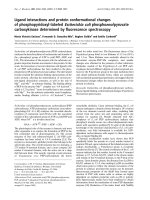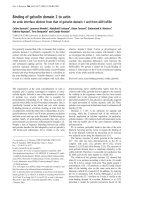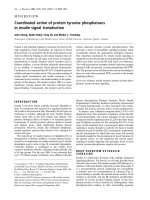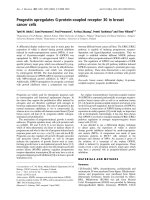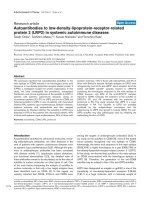Báo cáo y học: "Autoantibodies to low-density-lipoprotein-receptor-related protein 2 (LRP2) in systemic autoimmune diseases" pps
Bạn đang xem bản rút gọn của tài liệu. Xem và tải ngay bản đầy đủ của tài liệu tại đây (509.43 KB, 7 trang )
R174
Introduction
Autoantibodies (autoAbs) to cell-surface molecules, includ-
ing antilymphocyte antibodies, are often detected in the
sera of patients with systemic autoimmune diseases such
as systemic lupus erythematosus (SLE). Although the pres-
ence of antilymphocyte antibodies has been correlated
with disease activity [1], lymphocyte subset distortions,
and functional abnormalities [2,3], the detailed roles of
these antibodies remain to be elucidated, as do the roles of
autoAbs to surface molecules on other types of cell. One
of the main factors hampering the analysis of autoAbs to
surface molecules is that only a few target antigens have
been identified, such as CD45 [4]. In this regard, we
recently reported that CD28, CTLA-4, and CD69 were
among the targets of antilymphocyte antibodies [5,6]. In
our study on the autoAbs to CD69 [6], most of the tested
serum samples recognized only one epitope on CD69.
Interestingly, the amino acid sequence of this main epitope
(EKNLYWI) is highly homologous to a part (EKRLYWI) of
low-density-lipoprotein-receptor-related protein 2 (LRP2).
In that study, we showed that autoAbs to the main epitope
on CD69 cross-reacted with the homologous epitope in
LRP2 [6]. Therefore, the generation of the anti-CD69
autoAbs may be related to that of the anti-LRP2 autoAbs.
LRP2 (also designated as megalin or gp330) is one of the
superfamily of low-density-lipoprotein receptors (LDLRs)
[7,8]. It is a huge molecule, with a molecular weight of
autoAb = autoantibody; BP = base pairs; BSA = bovine serum albumin; CRP = C-reactive protein; ESR = erythrocyte sedimentation rate; LDLR =
low-density-lipoprotein receptor; LRP(1, 2) = low-density-lipoprotein-receptor-related protein (1, 2); MBP = maltose-binding protein; OA =
osteoarthritis; PBS = phosphate-buffered saline; RA = rheumatoid arthritis; RF = rheumatoid factor; rLRP2 = recombinant LRP2; SSc = systemic
sclerosis; SLE = systemic lupus erythematosus; WBC = white blood cell.
Arthritis Research & Therapy Vol 5 No 3 Ooka et al.
Research article
Autoantibodies to low-density-lipoprotein-receptor-related
protein 2 (LRP2) in systemic autoimmune diseases
Seido Ooka
1
, Toshihiro Matsui
1,2
, Kusuki Nishioka
1
and Tomohiro Kato
1
1
Department of Bioregulation, Institute of Medical Science, St Marianna University School of Medicine, Kawasaki, Kanagawa, Japan
2
Clinical Research Center for Allergy and Rheumatology, National Sagamihara Hospital, Kanagawa, Japan
Corresponding author: Tomohiro Kato (e-mail: )
Received: 14 Nov 2002 Revisions requested: 19 Dec 2002 Revisions received: 4 Feb 2003 Accepted: 6 Mar 2003 Published: 4 Apr 2003
Arthritis Res Ther 2003, 5:R174-R180 (DOI 10.1186/ar754)
© 2003 Ooka et al., licensee BioMed Central Ltd (Print ISSN 1478-6354; Online ISSN 1478-6362). This is an Open Access article: verbatim
copying and redistribution of this article are permitted in all media for any purpose, provided this notice is preserved along with the article's original
URL.
Abstract
We previously reported that autoantibodies (autoAbs) to the
main epitope on CD69 reacted to its homologous amino acid
sequence in low-density-lipoprotein-receptor-related protein 2
(LPR2), a multiligand receptor for protein reabsorption. In this
study, we have investigated the prevalence, autoepitope
distribution, and clinical significance of the autoAbs to LRP2 in
patients with systemic autoimmune diseases. Using six
recombinant proteins (F2–F7) for LRP2 and one for CD69, we
detected autoAbs to LRP2 in sera of patients with rheumatoid
arthritis (RA), systemic lupus erythematosus, Behçet’s disease,
systemic sclerosis, and osteoarthritis and then mapped
autoepitopes by Western blotting. The autoAbs to LRP2 were
detected in 87% of the patients with rheumatoid arthritis, 40%
of those with systemic lupus erythematosus, 35% of those with
systemic sclerosis, 15% of those with osteoarthritis, and 3% of
those with Behçet’s disease. Multiple epitopes on LRP2 were
recognized by most of the anti-LRP2
+
serum samples. All of the
tested anti-CD69 autoAb
+
samples reacted to LRP2-F3
containing the homologous sequence to the main epitope of
CD69; however, only 38% of the anti-LRP2-F3
+
samples
reacted to CD69. Clinically, the existence of the autoAbs to
LRP2-F4, -F5, and -F6 correlated with the presence of
proteinuria in RA. This study revealed that LRP2 is a major
autoantigen in RA. The autoAbs to LRP2 are probably
produced by the antigen-driven mechanism and the
autoimmunity to LRP2 may spread to include CD69. The anti-
LRP2 autoAbs may play pathological roles by inhibiting the
reabsorbing function of LRP2.
Keywords: autoantibody, CD69, LRP2, proteinuria
Open Access
Available online />R175
approximately 600 kDa, and contains four LDLR domains.
LRP2 is expressed in a variety of epithelia, such as renal
proximal tubule, epididymis, and thyroid cells. Because mice
lacking the gene for LRP2 exhibit a deficiency of proximal
tubule reabsorption and a significant reduction of the
number and size of organelles associated with endocytosis
in the proximal tubule [9], LRP2 is thought to play central
roles in reabsorption of proteins and endocytosis. More than
30 ligands for LRP2 have been reported so far, including
vitamin-binding proteins, apolipoproteins, hormones, and
other low-molecular-weight peptides, as reviewed in [8].
LRP2 was originally identified as a pathogenic autoantigen
in a rat experimental model of human membranous
glomerulonephritis (Heymann’s nephritis) [10], although
no pathological role has been shown in humans. Recently,
autoAbs to LRP2 have been reported in patients with
autoimmune thyroiditis [11]. However, no other data have
been available on the autoimmunity to LRP2 in humans.
Therefore, we have investigated the autoimmunity to LRP2
in systemic autoimmune diseases, focusing on prevalence,
autoepitope distribution, clinical significance, and anti-
genic relationships with the anti-CD69 autoAbs.
Materials and methods
Human sera
Serum samples were obtained from a total of 147 patients
with systemic autoimmune diseases, including 47 with
rheumatoid arthritis (RA) (35 females,12 males; mean age
57.2 years, range 22–79), 30 with SLE (28 females, 2
males; mean age 42.7 years, range 20–72), 30 with
Behçet’s disease (20 females, 10 males; mean age
50.9 years, range 24–78), 20 with osteoarthritis (OA) (14
females, 6 males; mean age 62.9 years, range 55–78) and
20 with systemic sclerosis (SSc) (17 females, 3 males;
mean age 52.9 years, range 29–71). Each patient was diag-
nosed according to the standard criteria for the disease in
question [12–16]. Serum samples from 75 healthy donors
(58 females, 17 males; mean age 49.7 years, range 22–82),
were used as age- and sex-matched control samples.
Plasmid construction for the expression of recombinant
LRP2 and CD69 molecules
Six cDNA fragments (cDNA
F2
to cDNA
F7
), each encoding
a part of the LRP2 molecule, were amplified by PCR from
cDNA prepared from thyroid cells. DNA primers were
designed based on the nucleotide (N) sequence of LRP2
(European Molecular Biology Laboratory U04441). The
sequences of the primers are as follows (the lower-case
letters indicate the restriction enzyme sites):
5′-TTTgaattcCTGATGCACCTGTGCCACACC-3′ and
5′-TTTgtcgacAAAAATGAGATAGGGTTCGATGTTA-3′
for cDNA
F2
(N9294–9713),
5′-TTTgaattcAACAGTAACATCGAACCCTATCTC-3′ and
5′-TTTgtcgacATTGTTGGTACCACAGGGATTGC-3′
for cDNA
F3
(N9684–10523),
5′-TTTggatccAATCCCTGTGGTACCAACAATGGT-3′ and
5′-TTTgtcgacACAGCCTTGCTCATCACTGTTGTC-3′
for cDNA
F4
(N10494–11180),
5′-TTTgaattcGAATTCAGCTGCAAAACAAATTAC-3′ and
5′-TTTgtcgacCTCTGTCTCATCAGTTCCATCTCC-3′
for cDNA
F5
(N11157–11855),
5′-TTTggatccACTGATGAGACAGAGGAGCACTGT-3′ and
5′-TTTgtcgacATCAACAGCTTGGATATATTCCTCATC-3′
for cDNA
F6
(N11826–12374),
5′-TTTgaattcCGAAAATATAATCTCTCATCT-3′ and
5′-TTTgtcgacCTGTTTGCAAAGGTTGGGCACTGA-3′
for cDNA
F7
(N12345–13112).
These cDNA fragments covered approximately one-third
(N9294–13112) of the entire LRP2 molecule (N74–14072,
13999 bp), with some overlaps. Each of the six cDNA
fragments was cloned into the EcoRI/SalI or BamHI/SalI
sites of the pMAL-eHis, a derivative of the pMAL-c expres-
sion vector (New England Biolabs, Beverly, MA, USA),
designated as pMAL-eHis-LRP2
F2
to pMAL-eHis-LRP2
F7
,
respectively. The inserted cDNA fragments were
expressed as a hybrid protein with maltose-binding protein
(MBP). Recombinant CD69 as an MBP fusion protein was
similarly prepared, as we described earlier [6]. Purification
of the recombinant fusion proteins were performed using
Ni-chelated columns (HiTrap Chelating, Amersham Bio-
sciences, Piscataway, NJ, USA), in accordance with the
manufacturer’s instructions.
Western blotting
Western blotting was performed as described previously
[6]. Briefly, 5 µg of each purified protein was separated by
12.5% SDS–PAGE and then transferred onto a nitrocellu-
lose membrane. After blocking with PBS containing 1%
BSA and 0.1% Tween 20 (PBS-BT) for 1 hour, the mem-
branes were washed in PBS with 0.1% Tween 20 for
30 min. Then each membrane was incubated for 1 hour
with each serum sample, which had been previously
diluted 1:100 with PBS-BT and preincubated with
20 µg/ml of bacterial lysate containing nonrecombinant
pMAL
TM
-c product for 2 hours at room temperature. The
membrane was washed as before, and the bound antibod-
ies were put to react with horseradish-peroxidase-conju-
gated goat antihuman IgG (Zymed Laboratories, San
Francisco, CA, USA) diluted 1:2000 with PBS-BT for
30 min. The bound antibodies were visualized with
diaminobenzidine.
Laboratory findings and statistical analysis
Laboratory findings are expressed as the mean ± standard
error of the mean. The Mann–Whitney U test and Fisher’s
exact test were used to test the significance of differences
between the laboratory findings for the patients with and
Arthritis Research & Therapy Vol 5 No 3 Ooka et al.
R176
without anti-LRP2 autoAbs. P values of less than 0.05
were considered to be statistically significant. The protein-
uria was measured semiquantitatively by Urieflet S (Arkray,
Inc, Osaka, Japan), in which the degree of proteinuria of
more than approximately 30, 50, 70, and 100 mg/dl was
expressed as 1+, 2+, 3+ and 4+, respectively. The
degrees of proteinuria were 1+ in four, 2+ in two, and 3+
in two of the eight proteinuria-positive patients with RA.
Results
Expression of the recombinant LRP2 molecules
To investigate autoepitopes of LRP2, we prepared recom-
binant LRP2 proteins. Since LRP2 is such a huge mole-
cule, it was difficult to search all autoepitopes on the
entire molecule in Escherichia coli. Therefore, we focused
on approximately one-third of the entire region, which cor-
responded to the proximal end of its extracellular region.
This region contains the CD69-homologous amino acid
sequence and one of the LDLR domains, which were
thought to bind various ligands such as apolipoprotein Eβ
very-low-density lipoproteins, lactoferrin, and aprotinin
[17] (Fig. 1). We divided the region with 1273 amino acid
residues into six regions, F2–F7, and amplified cDNA for
each region by RT-PCR (cDNA
F2
–cDNA
F7
). The
nucleotide sequences of each amplified DNA fragment
were confirmed to be identical to those reported previ-
ously [18]. They were expressed as an MBP fusion
protein, recombinant LRP2 (rLRP2). The produced and
purified proteins of rLRP2-F2, -F3, and -F7, and rCD69
showed their expected molecular weights on staining with
Ponceau S after SDS–PAGE separation and transfer to
the membrane (Fig. 2, upper panel). In the case of rLRP2-
F4, -F5, and -F6, the molecular weights of the produced
fusion proteins were approximately 10 kDa heavier than
expected. This slowed mobility in the SDS gels is possibly
due to aberrant binding of SDS or additional translation of
the LacZ-α gene downstream of the multiple cloning sites.
However, full expression of each of the rLRP2-F2 to -F7
regions was confirmed by positive staining of its C-termi-
nal histidine tag with horseradish-peroxidase-conjugated
nickel triacetoacid on Western blotting (data not shown).
Therefore, we judged that they were good enough to be
used to investigate the reactivity of serum samples.
Reactivity of the sera of patients with systemic
autoimmune diseases to the rLRP2 proteins
Using the rLRP2 prepared as above, we used Western blot-
ting to investigate whether autoAbs to rLRP2 were present
in sera of patients with systemic autoimmune diseases. We
detected IgG-type autoAbs to at least one fragment of the
rLRP2 molecules in 41 (87%) of the 47 patients with RA,
12 (40%) of the 30 patients with SLE, 7 (35%) of the 20
patients with SSc, 3 (15%) of the 20 patients with OA, 1
(3%) of the 30 patients with Behçet’s disease, and 4 (5%)
of the 75 healthy donors. Representative results of the
Western blotting in RA, SLE, and SSc are shown in Fig. 2.
The reactivities of the positive serum samples are summa-
rized in Table 1. One serum sample recognized 2.7 frag-
ments on average and the epitope(s) in the F3 region were
recognized most frequently. The F3 region of LRP2 con-
tains continuous seven amino acid residues homologous to
Figure 1
Map of low-density-lipoprotein-receptor-related protein 2 (LRP2). Six gene fragments that, with overlaps, covered approximately one-third of the
extracellular region of human LRP2 were obtained by RT-PCR. They were then expressed as a maltose-binding protein (MBP) fusion protein. EGF,
epidermal growth factor; LDL, low-density lipoprotein.
CD69, as shown in Fig. 1, and in our previous study the
residues were found to be dominant autoepitopes of CD69
in RA [6]. We therefore investigated whether autoAbs to
rLRP2-F3 were directed toward the CD69-homologous
amino acid sequence by investigating reactivity to the
rCD69 molecule in Western blotting. As shown in Table 1,
all of the 14 anti-CD69 autoAb
+
serum samples reacted to
rLRP2-F3; however, 23 (62%) of the 37 anti-rLRP2-F3
autoAb
+
samples did not react to rCD69 in RA. Including
all the disease categories and healthy donors tested, 62%
of the anti-rLRP2-F3 autoAb
+
samples did not react with
rCD69. This indicates that there are multiple autoepitopes
on the F3 region, one of which is the CD69-homologous
epitope, as mentioned above.
In the patients with SLE, the F3 region was not the domi-
nant epitope region. Instead, rLRP2-F5 was recognized by
9 (75%) of the 12 anti-rLRP2 autoAb
+
serum samples,
and recognition of other fragments was not more than
25% (Table 1). One serum sample recognized 1.5 frag-
ments on average. Thus the distribution and numbers of
the recognized autoepitopes appeared different from
those in RA. In the patients with SSc and those with OA,
the main epitope appeared to be located in the F3 region,
but the percentage of serum samples that recognized
rLRP2-F3 was lower than in RA.
Laboratory findings for anti-rLRP2 autoAb
+
and autoAb
–
patients with RA
Since anti-rLRP2 autoAbs were detected most frequently
in the sera of patients with RA, we first compared the lab-
oratory findings for the anti-rLRP2 autoAb
+
and autoAb
–
patients with RA. Two values of clinical findings differed
significantly between the two groups. First, the anti-rLRP2
autoAb
+
patients displayed proteinuria more frequently.
Within the anti-rLRP2 autoAb
+
population, patients who
had positive tests for anti-rLRP2-F4, -F5, or -F6 had protein-
uria more frequently (Table 2). Second, the serum levels of
IgA were significantly higher in the anti-rLRP2-F6 autoAb
+
patients than in the autoAb
–
ones (373.6 ± 170.6 mg/dl vs
244.2 ± 105.6 mg/dl, P = 0.007). The peripheral lympho-
cyte counts, white blood cell (WBC) counts, platelet
counts, rheumatoid factors (RFs), erythrocyte sedimenta-
tion rate (ESR), C-reactive protein (CRP), and serum
levels of IgG and IgM did not differ between the two
groups (data not shown).
Similarly, we compared the laboratory findings for the anti-
rLRP2 autoAb
+
and autoAb
–
patients in SLE and SSc (in
SLE, positivity for proteinuria; titers of anti-dsDNA
autoAbs, anti-Sm autoAbs, and RF; WBC, lymphocyte,
and platelet counts; serum levels of CRP, IgG, and IgM;
and ESR; and, in SSc, positivity of proteinuria; titers of
anti-nuclear antibodies, anti-Scl-70 autoAbs, and RF;
WBC, lymphocyte, and platelet counts; serum levels of
CRP, IgG, and IgM; and ESR). However, no significant dif-
ference was found (data not shown).
Discussion
Our results can be summarized as follows:
1. Anti-rLRP2 autoAbs were detected in 87% of the RA
patients tested, less frequently in SLE, SSc, and OA,
and only rarely in Behçet’s disease and healthy donors.
2. Multiple autoepitopes were identified on the LRP2
molecule.
3. Almost all the anti-LRP-2
+
RA serum samples reacted
to the F3 fragment, which contains an amino acid
sequence homologous to CD69, and 71% of the anti-
LRP2
+
SSc serum samples reacted to the F3 frag-
ment, but only 8% of the anti-LRP-2
+
SLE serum
samples reacted to the F3 fragment.
Available online />R177
Figure 2
Recombinant proteins and representative results of Western blotting.
Recombinant LRP2 F2–F7 fragments, CD69, and maltose-binding
protein (MBP) were separated by 12.5% SDS–PAGE and were
transferred onto nitrocellulose membranes. The membranes were
stained with Ponceau S (top panel) or reacted with serum samples
diluted at 1:100 (lower five panels). Representative results from
patients with RA (RA-18, RA-19 and RA-21) , SLE (K-23), and SSc
(SSc-85) are shown. RA, rheumatoid arthritis; SLE, systemic lupus
erythematosus; SSc, systemic sclerosis.
Arthritis Research & Therapy Vol 5 No 3 Ooka et al.
R178
Table 1
Reactivity of serum samples to the CD69 and to fragments of LRP2
Recombinant protein
LRP2
Disease No. of sera CD69 F2 F3 F4 F5 F6 F7
RA (n = 47)
6––+–––+
6––+––––
4+++++++
3+–++–++
3+–+–––+
2–++––++
2+++––––
2––+–+–+
2––++–––
2––+––+–
2–––+–––
1+–+++++
1+–+–+–+
1––+–+++
1––++–+–
1–––+++–
1––––+++
1––+–+––
Total sera 41
Positive reactions [No. (%)] 14 (34) 8 (20) 37 (90) 14 (34) 12 (29) 16 (39) 24 (58)
SLE (n = 30)
6––––+––
2––––++–
2–––+–––
1+++–+–+
1––––––+
Total sera 12
Positive reactions [No. (%)] 1 (8) 1 (8) 1 (8) 2 (17) 9 (75) 2 (17) 2 (17)
SSc (n = 20)
2–+–––––
2––+––––
2–++––––
1––+–––+
Total sera 7
Positive reactions [No. (%)] 0 (0) 4 (57) 5 (71) 0 (0) 0 (0) 0 (0) 1 (14)
OA (n = 20)
1+++–––+
1––+–––+
1–––––+–
Total sera 3
Positive reactions [No. (%)] 1 (33) 1 (33) 2 (67) 0 (0) 0 (0) 1 (33) 2 (67)
None (healthy controls) (n = 75)
2––+–––+
2––––+––
Total sera 4
Positive reactions [No. (%)] 0 (0) 0 (0) 2 (50) 0 (0) 2 (50) 0 (0) 2 (50)
LRP2 = low-density-lipoprotein-receptor-related protein 2; OA = osteoarthritis; RA = rheumatoid arthritis; SLE = systemic lupus erythematosus;
SSc = systemic sclerosis.
4. All of the tested anti-CD69
+
serum samples reacted to
F3, but only 38% of the anti-F3
+
serum samples
reacted to the rCD69.
5. Anti-F4
+
, anti-F5
+
, and anti-F6
+
patients with RA had
proteinuria more frequently than those with negative
results for these antibodies, and the serum IgA level
was significantly higher in anti- F6
+
patients than in the
negative group in RA.
Regarding the first point, we had already shown that the
anti-CD69 autoAbs reacted to LRP2 [6]. Further, autoAbs
to LRP2 were detected in 50% of patients with autoim-
mune thyroiditis [11]. These findings encouraged us to
investigate autoAbs to LRP-2 in systemic autoimmune dis-
eases. We found that 87% of the tested RA serum
samples reacted to at least one fragment of LRP2. Since
our recombinants covered only about one-third of the
LRP-2 molecule and would not express conformational
epitopes, the frequency of the autoAb to LRP2 might be
found to be higher than 87% if the whole and/or native
molecule of LRP2 were available. In the comparison
according to disease category, the anti-LRP2 autoAbs
were detected most frequently in RA, less frequently in
SLE, SSc, and OA, and only rarely in Behçet’s disease.
The high prevalence of the anti-LRP2 autoAbs in RA indi-
cates that this autoAb is probably a marker for RA, even
though it is not highly specific for RA. In addition, autoAbs
to LRP2 were found more frequently in patients with OA
(15%) than in healthy donors (5%). Although more
patients with OA should be studied, it seems likely that
autoimmunity may be involved in the pathogenesis of OA,
since various autoAbs have been reported in OA recently
[19,20].
Regarding points 2 to 4, the recognition of multiple epi-
topes indicates that the anti-LRP2 autoimmunity is
antigen-driven. Previously, we showed that about 30% of
the serum samples from RA patients carried autoAbs to
CD69 and that almost all of the positive samples reacted
to the epitope shared by CD69 and LRP2 (EKNLYWI in
CD69 and EKRLYWI in LRP2) [6]. The epitope in LRP2 is
located in the F3 region. In our study, in RA, 37 (90%) of
the 41 serum samples tested reacted to rLRP2-F3,
showing that the F3 region contains dominant epitopes of
LRP2. However, only 14 of the 37 anti-rLRP2-F3
+
samples reacted to CD69 and all 14 of the anti-CD69
+
samples reacted to rLRP2-F3. These two observations
taken together indicate that there are at least two epitopes
within the F3 region and that one of them is the shared
epitope of EKRLYWI. Considering that most of the anti-
CD69 autoAb
+
serum samples reacted exclusively to the
shared epitope and that LRP2 has multiple epitopes, we
think that the anti-CD69 autoAb may be among the anti-
LRP-2 autoAbs in RA.
Regarding point 5, we found that possession of the anti-
LRP2 autoAbs, in particular anti-rLRP2-F4, -F5, or -F6
autoAbs, was associated with the presence of proteinuria in
RA. The patients with positive proteinuria had no past
history of renal diseases before the onset of RA. Further, the
use of antirheumatic drugs, including nonsteroidal anti-
inflammatory drugs, disease-modifying antirheumatic drugs,
and steroids, were similar and produced no significant dif-
ference between proteinuria-positive and -negative patients
(data not shown). We deduce that the proteinuria is related
to the disease process of RA. Interestingly, LRP2 is a patho-
genic autoantigen that causes experimental glomeru-
lonephritis in rats, Heymann’s nephritis [10]. Further, the F4,
F5, and F6 regions corresponded to the entire fourth LDLR
domain of LRP2, which is thought to be a ligand-binding
region (see Fig. 1). This suggests that the autoimmunity to
LRP2 may cause the proteinuria by immunological attack of
LRP2. However, no significant correlation between protein-
uria and the anti-LRP2 autoAbs was found in SLE, even
though nephritis is one of the major manifestations of SLE.
Therefore, the autoimmunity to LRP2 is probably not a criti-
cal factor for lupus nephritis, and other factors, such as anti-
DNA autoAbs, would be more important. Further studies are
needed to elucidate the different mechanisms of proteinuria
between RA and SLE.
Conclusion
Our study indicated that LRP2 was a major autoantigen in
systemic autoimmune diseases. The anti-LRP2 autoanti-
bodies may play pathological roles by affecting functions
of LRP2
Available online />R179
Table 2
Correlation between the presence of anti-LRP2 autoantibodies
and of proteinuria in patients with rheumatoid arthritis
Proteinuria in patients
Absent (n = 39) Present (n = 8)
Autoantibody [No. (%)] [No. (%)]
Anti-F2 (–) 33 (85) 6 (75)
(+) 6 (15) 2 (25)
Anti-F3 (–) 9 (23) 1 (12)
(+) 30 (77) 7 (88)
Anti-F4 (–) 31 (80) 2 (25)
(+) 8 (20) 6 (75)
a
Anti-F5 (–) 32 (82) 3 (38)
(+) 7 (18) 5 (62)
b
Anti-F6 (–) 29 (74) 2 (25)
(+) 10 (26) 6 (75)
c
Anti-F7 (–) 19 (49) 4 (50)
(+) 20 (51) 4 (50)
a
P = 0.005,
b
P = 0.018,
c
P = 0.013 (Fisher’s exact probability test).
LRP2, low-density-lipoprotein-receptor-related protein 2.
Competing interests
None declared.
Acknowledgements
This work was supported by in part by grants-in-aid from the Ministry of
Health and Welfare and the Ministry of Education, Science, and
Culture of Japan, and the Japan Rheumatism Foundation.
References
1. Winfield JB, Mimura T: Pathogenetic significance of anti-
lymphocyte autoantibodies in systemic lupus erythematosus.
Clin Immunol Immunopathol 1992, 63:13-16.
2. Sakane T, Steinberg AD, Reeves JP, Green I: Studies of immune
functions of patients with systemic lupus erythematosus. T-
cell subsets and antibodies to T-cell subsets. J Clin Invest
1979, 64:1260-1269.
3. Morimoto C, Schlossman SF: Antilymphocyte antibodies and
systemic lupus erythematosus. Arthritis Rheum 1987, 30:225-
228.
4. Czyzyk J, Fernsten P, Shaw M, Winfield JB: Cell-type specificity
of anti-CD45 autoantibodies in systemic lupus erythemato-
sus. Arthritis Rheum 1996, 39:592-599.
5. Matsui T, Kurokawa M, Kobata T, Oki S, Azuma M, Tohma S,
Inoue T, Yamamoto K, Nishioka K, Kato T: Autoantibodies to T
cell costimulatory molecules in systemic autoimmune dis-
eases. J Immunol 1999, 162:4328-4335.
6. Yu X, Matsui T, Otsuka M, Sekine T, Yamamoto K, Nishioka K,
Kato T: Anti-CD69 autoantibodies cross-react with low density
lipoprotein receptor-related protein 2 in systemic autoim-
mune diseases. J Immunol 2001, 166:1360-1369.
7. Hussain MM: Structural, biochemical and signaling properties
of the low-density lipoprotein receptor gene family. Front
Biosci 2001, 6:D417-D428.
8. Christensen EI, Birn H: Megalin and cubilin: synergistic endo-
cytic receptors in renal proximal tubule. Am J Physiol Renal
Physiol 2001, 280:F562-F573.
9. Willnow TE, Hilpert J, Armstrong SA, Rohlmann A, Hammer RE,
Burns DK, Herz J: Defective forebrain development in mice
lacking gp330/megalin. Proc Natl Acad Sci USA 1996, 93:
8460-8464.
10. Kerjaschki D, Farquhar MG: The pathogenic antigen of
Heymann nephritis is a membrane glycoprotein of the renal
proximal tubule brush border. Proc Natl Acad Sci USA 1982,
79:5557-5581.
11. Marino M, Chiovato L, Friedlander JA, Latrofa F, Pinchera A,
McCluskey RT: Serum antibodies against megalin (GP330) in
patients with autoimmune thyroiditis. J Clin Endocrinol Metab
1999, 84:2468-2474.
12. Tan EM, Cohen AS, Fries JF, Masi AT, McShane DJ, Rothfield NF,
Schaller JG, Talal N, Winchester RJ: The 1982 revised criteria
for the classification of systemic lupus erythematosus. Arthri-
tis Rheum 1982, 25:1271-1277.
13. Criteria for diagnosis of Behcet’s disease. International Study
Group for Behçet’s Disease. Lancet 1990, 335:1078-1080.
14. Arnett FC, Edworthy SM, Bloch DA, McShane DJ, Fries JF, Cooper
NS, Healey LA, Kaplan SR, Liang MH, Luthra HS, Medsger TA,
Mitchell DM, Neustadt DH, Pinals RS, Schaller JG, Sharp JT,
Wilder RL, Hunder GG: The American Rheumatism Associa-
tion 1987 revised criteria for the classification of rheumatoid
arthritis. Arthritis Rheum 1988, 31:315-324.
15. Altman R, Asch E, Bloch D, Bole G, Borenstein D, Brandt K,
Christy W, Cooke TD, Greenwald R, Hochberg M, Howell D,
Kaplan D, Koopman W, Longley S, Mankin H, Mcshane DJ,
Medsger TJ, Meenan R, Mikkelsen W, Moskowitz R, Murphy W,
Rothschild B, Segal M, Sokoloff L, Wolfe F: Development of cri-
teria for the classification and reporting of osteoarthritis.
Classification of osteoarthritis of the knee. Diagnostic and
Therapeutic Criteria Committee of the American Rheumatism
Association. Arthritis Rheum 1986, 29:1039-1049.
16. Preliminary criteria for the classification of systemic sclerosis
(scleroderma). Subcommittee for scleroderma criteria of the
American Rheumatism Association Diagnostic and Therapeu-
tic Criteria Committee. Arthritis Rheum 1980, 23:581-590.
17. Orlando RA, Exner M, Czekay RP, Yamazaki H, Saito A, Ullrich R,
Kerjaschki D, Farquhar MG: Identification of the second cluster
of ligand-binding repeats in megalin as a site for receptor-
ligand interactions. Proc Natl Acad Sci USA 1997, 94:2368-
2373.
18. Hjalm G, Murray E, Crumley G, Harazim W, Lundgren S, Onyango
I, Ek B, Larsson M, Juhlin C, Hellman P, Davis H, Akerstrom G,
Rask L, Morse B: Cloning and sequencing of human gp330, a
Ca(2+)-binding receptor with potential intracellular signaling
properties. Eur J Biochem 1996, 239:132-137.
19. Tsuruha J, Masuko-Hongo K, Kato T, Sakata M, Nakamura H,
Sekine T, Takigawa M, Nishioka K: Autoimmunity against YKL-
39, a human cartilage-derived protein in patients with
osteoarthritis. J Rheumatol 2002, 29:1459-1466.
20. Tsuruha J, Masuko-Hongo K, Kato T, Sakata M, Nakamura H, Nish-
ioka K: Implication of cartilage intermediate layer protein
(CILP) in cartilage destruction in subsets of patients with
osteoarthritis and rheumatoid arthritis. Arthritis Rheum 2001,
44:838-845.
Correspondence
Tomohiro Kato, MD, PhD, Department of Bioregulation, Institute of
Medical Science, St Marianna University School of Medicine,
Kawasaki, Kanagawa, 216-8512, Japan. Tel: +81 44 977 8111, exten-
sion 4209; fax: +81 44 978 2036; e-mail:
Arthritis Research & Therapy Vol 5 No 3 Ooka et al.
R180
